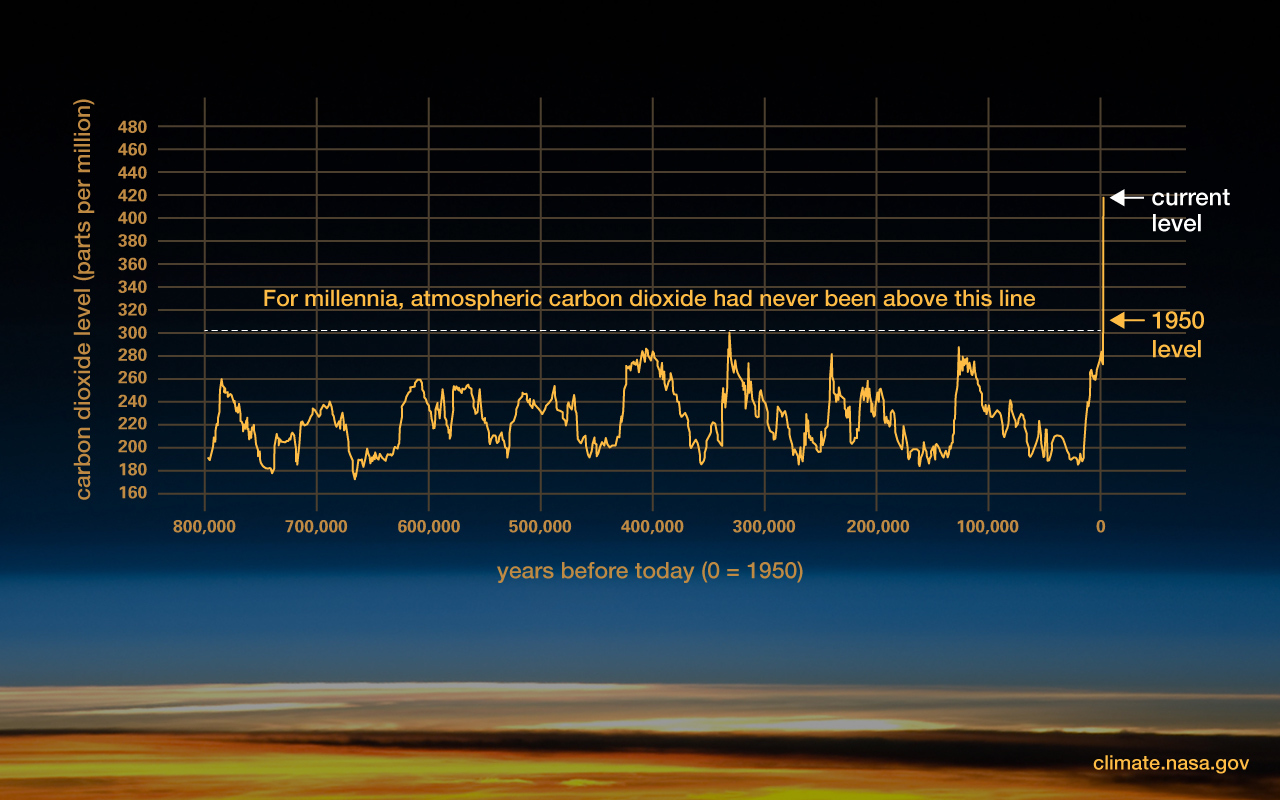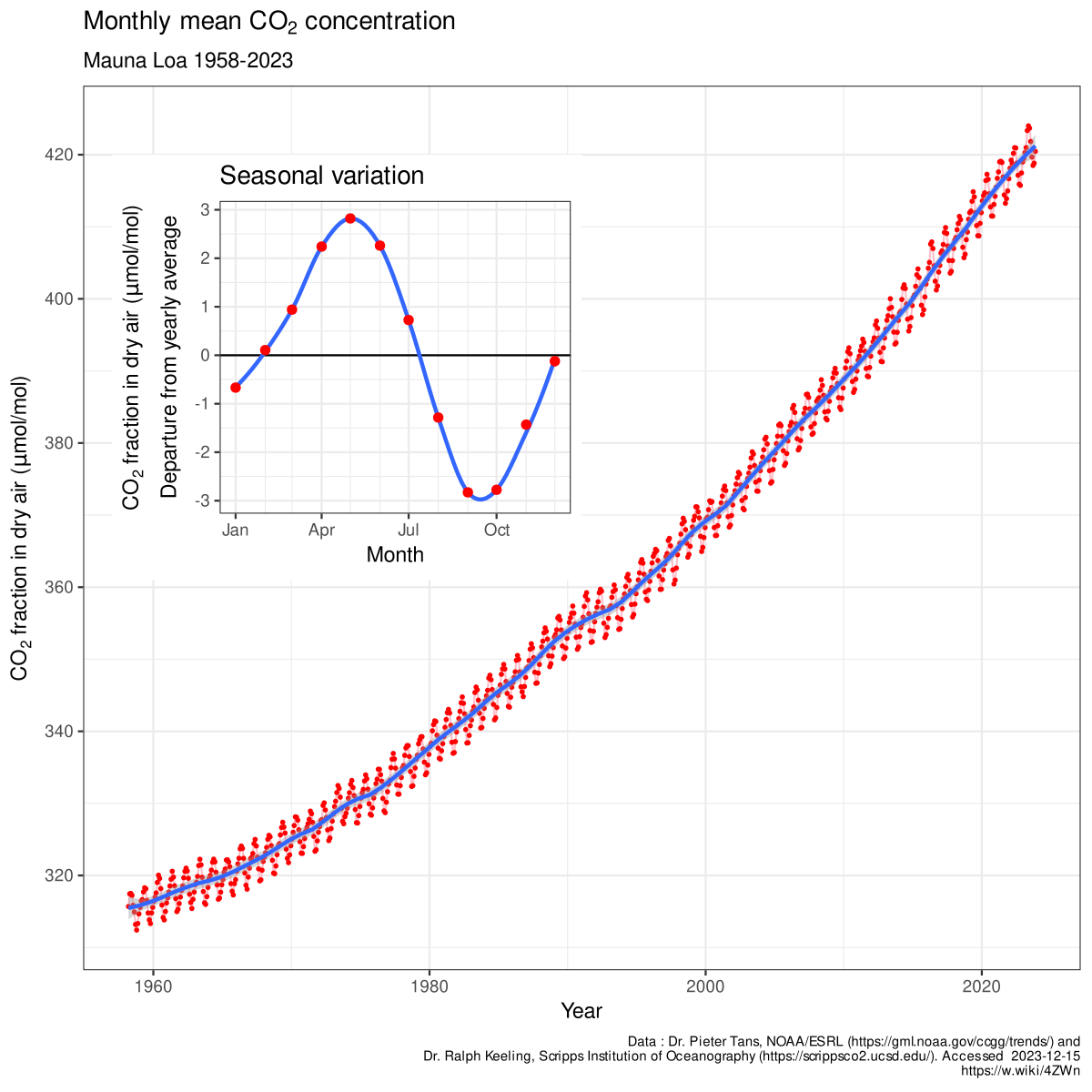- Dec 18, 2013
- 136,363
- 27,905
- 2,180
We don’t have anything to worry about, why are you worried?Then we have nothing to worry about, there is food aplenty and it is cheap, no one is starving.
Follow along with the video below to see how to install our site as a web app on your home screen.

Note: This feature currently requires accessing the site using the built-in Safari browser.
We don’t have anything to worry about, why are you worried?Then we have nothing to worry about, there is food aplenty and it is cheap, no one is starving.
I'm have trouble coming with your 17,000ppm for co2 at that time period. The research I have found(Texas AM 2019 and NASA's 2021 climate Study) shows the entire Pleistocene Epoch, that the covers 2.58 million to 11,700 years ago had an average CO2 ppm of 250.The Earth Needs More CO2, not Less
I know this statement will make people’s head explode, but it’s true, Earth needs more CO2, not less. Let’s look at the science with a bit of common sense.
Carbon dioxide has gone up and down over millions of years, but the trend has always been, on the whole, down. A quarter of a million years ago, there was 17,000 ppm. Today it is around 410 ppm. Forget for a moment the clumsy “parts per million” scale and just look at the numbers by comparison.
Back then, the earth didn’t blow up in flames as people try to scare us into believing. But everything was big. Animals were the size of small apartment complexes and leaves were the size of a Mini Cooper. That is because, as every farmer and pot grower knows, “you want plants to grow more? You pump in CO2". But, from 17,000 whatevers to 410 whatevers, where did the CO2 go? In a word, the “pyramids”. Let’s go back to the beginning.
We owe life on earth to carbon and more specifically, CO2. Every first year biology student knows the equation for photosynthesis:
View attachment 527372
That is, plants take in water and carbon dioxide and, after growing a bit, spit out oxygen. Without this process, life on earth would not exist. Of course, humans breath in oxygen and exhale carbon dioxide which, in effect, reverses this equation. What a coincidence, right? Anyway, you increase the concentration of the CO2 on the left side of the equation and it pushes the equation to the right giving you more plants and more oxygen. So, what is the problem here? Well, we are told that CO2 is a pollutant. More about that in a minute. But first, where did all the CO2 go? If the earth had 17,000 ppm in the atmosphere and now only has 410 ppm, where in the hell is it? Let’s look at that.
First, we all know that a portion (how big, who knows?) went into the earth in the form of oil. All of the big plants and huge dinosaurs died and got buried. They rotted deep in the earth and became oil. Over a couple hundred million years this oil is typically very deep. As every archeologist knows, the deeper you go the farther back in time you go. But this is only part of the story. Maybe less than half. The other large, and scarier portion is “The Great Barrier Reef!”.
The earliest arthropods formed around 500 million years ago but their bodies were soft and didn’t become hard like the crustaceans we know today until, ..wait for it…a quarter million years ago. Right when we had that 17,000 ppm of carbon dioxide in the atmosphere. The sneaky part is that these hard little suckers take carbon dioxide out of the atmosphere and create their shells out of calcium carbonate thereby sequestering the CO2 in their sneaky little bodies. They die and become part of bottom of the ocean which now can be found on every continent and at the top of every mountain. On land, this forms a semi-hard rock called limestone which the Egyptians thought was a great rock to build pyramids. There you have it! Pyramids!
The problem with this is that it is a one-way process. We cannot burn limestone in our cars to put this CO2 back into circulation and nobody is going to let us dig up the Great Barrier Reef to reprocess the coral. So we sit with 410 ppm of CO2 in our atmosphere. Is it enough to run this show? Well, let’s look at it.
When we had walking giants, there was plant life on every part of the Earth. The Sahara Dessert had trees and even Antarctica had forests. Was this bad? Don’t know, we weren’t there. But the life that was there loved it. And now, at 410 ppm, we have seemingly lifeless deserts all around the world. Start in the Gobi Desert, go to the Middle East, then to the Sahara Desert, shoot past the Gulf of Mexico into the United States Southwest and Mexico. Deserts, deserts, deserts. You can do the same in the Southern Hemisphere. Interestingly, the deserts are not on the equator where you would expect, but about a third of the way north of the equator and a third of the way south of the equator. This is another paper to discuss why. But, if this process of sequestering CO2 into crustaceans’ greedy little bodies is an ongoing process, then we can’t stop it. And, how little CO2 can we have in the atmosphere and still maintain left on Earth?
Most scientists believe that life on Earth, as we know it, cannot exist with atmospheric CO2 below around 150 to 175 ppm. Fifty years ago we were around 270 ppm when CO2 started its creep up from possible oblivion. Whew!, that was close. Of course, that is when activists started blaring the alarm of catastrophe due to “Man Caused Global Warming”. Actually, they stated it was global cooling and when that didn’t happen, they reversed course to global warming. When that didn’t happen they gave up on predictions and just settled on the amorphous and non-committal “Climate Change”. But, how in the hell did CO2, that which makes life possible, become a pollutant?
Although global cooling was considered a major problem since the 1970s, on June 23, 1988 Dr. James Hansen told Congress that carbon dioxide was causing the Earth to warm, the increase in carbon dioxide was manmade and this was catastrophic. We were off to the races.
Then, in 2014, Naomi Klein wrote a book delineating the significance of this revelation to the world’s socialists called, “This Changes Everything, Capitalism vs. The Climate”. The book describes how if you control carbon dioxide, you control energy, and if you control energy, you control the economy, control the economy and control the world. Wow, this is better than universal healthcare.
Meanwhile, without regard to the politics, CO2 has been increasing little-by-little and in response, you guessed it, there is a concomitant greening of the world’s deserts. Not a lot, but satellite imagery shows a greening around the edges of the world’s largest deserts. A bad thing? Meanwhile, if you put into your computer that an increase in CO2 is an increase in the temperature of the Earth, presto!, you get predictions that have never come true. GIGO.
Does an increase in CO2 cause an increase in global temperatures? All things being equal, yes. But all things are never equal. You have the temperature fluctuations of the sun and you have water vapor in the atmosphere among a host of other things. But, let’s look at water vapor for a second.
CO2 is a greenhouse gas. So is water vapor. Without getting into the messiness of science and elevation changes of CO2, mixing and atmospheric changes, etc., the concentration of CO2 is only 410 ppm. Water is around 20,000 to 30,000 ppm on the average. Or, around 10,000 times the concentration. What do scientists say about water vapor and cloud cover with regard to Climate Change? They tend to ignore it. Too complicated. Let’s move on to something fun. So, the science is not settled. It never is. We don’t know what gravity is. We just changed the decades long food pyramid upside down. Science, by definition, is inquiry. Always asking questions. Anybody who says, “The science is settled” is a liar or a fool. Maybe both.
So, now, imagine the graph of CO2. It goes from 17,000 down to 270, skips off the bottom, then up to 410. Do we need to go lower or higher? You decide.
Jema Tell


I'm have trouble coming with your 17,000ppm for co2 at that time period. The research I have found(Texas AM 2019 and NASA's 2021 climate Study) shows the entire Pleistocene Epoch, that the covers 2.58 million to 11,700 years ago had an average CO2 ppm of 250.
"Titled "Low CO2 levels of the entire Pleistocene Epoch" and published in Nature Communications today, the study shows that for the entire 2.5 million years of the Pleistocene era, carbon dioxide concentrations averaged 250 parts per million. Today's levels, by comparison, are more than 410 parts per million.'

Humankind did not live with a high-carbon dioxide atmosphere until 1965
Humans have never before lived with the high carbon dioxide atmospheric conditions that have become the norm on Earth in the last 60 years, according to a new study.www.sciencedaily.com


Graphic: The relentless rise of carbon dioxide
The relentless rise of carbon dioxide levels in the atmosphere.climate.nasa.gov
Do you have a link for the text in your post? Also who is Jema Tell. I Googled the name and didn't find anything.

The link does not address the 17,000 ppm in Pleistocene era which is stated as if it were accepted fact with no explanation nor supporting facts. This is called a logical fallacy of assumption.
Carbon dioxide in Earth's atmosphere - Wikipedia
en.m.wikipedia.org
The link does not address the 17,000 ppm in Pleistocene era which is stated as if it were accepted fact with no explanation nor supporting facts. This is called a logical fallacy of assumption.
Carbon dioxide in Earth's atmosphere - Wikipedia
en.m.wikipedia.org
The link does not address the 17,000 ppm in Pleistocene era which is stated as if it were accepted fact with no explanation nor supporting facts. This is called a logical fallacy of assumption.
Carbon dioxide in Earth's atmosphere - Wikipedia
en.m.wikipedia.org
The link does not address the 17,000 ppm in Pleistocene era which is stated as if it were accepted fact with no explanation nor supporting facts. The poster goes on to build a case for increased CO2 levels based on this assumed fact.. This is called a logical fallacy of assumption.
Carbon dioxide in Earth's atmosphere - Wikipedia
en.m.wikipedia.org
I was the first one to suggest this a few posts ago.There is a link in the past between changing CO2 levels and changing temperatures in our atmosphere. The fact of the matter is that the temperature of the Earth controls the amount of CO2 in the atmosphere. It's not the other way around.
Find a post of mine that suggests that I'm worried.We don’t have anything to worry about, why are you worried?
You sound like a person that is woefully uninformed.
Famine is trending upwards. Upset weather (climate?) is reducing harvests, high fertilizer prices are causing farmers to use less. Weather is everything in farming, technology a distant second and can be mitigated by war and economic upheaval. Many third world farmers can no longer afford to farm thanks to 'technology'.

Global hunger fell for decades, but it's rising again
A major UN Food and Agriculture Organization report warns global hunger is rising, and the pandemic will make this worse. But it also sees ‘significant opportunities’ to turn things around.www.weforum.org

importance of weather in farming - Bing
Intelligent search from Bing makes it easier to quickly find what you’re looking for and rewards you.www.bing.com
You need to watch this.
India farmers can't afford to farm - Search Videos
www.bing.com
Remember, the truth behind the elites plan was on the Georgia Stones. Depopulate by 2/3 rds the population! Hahaha! A way to do that is famine and plagues! We got one plague under our belts now famine
That fermentation process releases CO2. That's why you should ferment your beer and wine in the same room where you grow your marijuana. That CO2 is plant food!
So you don't believe NOAA? ... okay ... you're choice ...

Do you know the difference between climate and weather? ...
Explain to me why average weather is different today than 100 years ago? ... let's pick India ...
You're quoting science. That means even you think we need to depend upon it .It won't work...species extinction has a 97% success rate....pretty doubtful that we will beat it.
You're quoting science. That means even you think we need to depend upon it .
Well then, we have enough science to pretty much tell us in which direction we should be heading, renewables.Of course we do....never said otherwise....
Got no problem with renewables... Still think that the AGWS are missing the big picture though....Well then, we have enough science to pretty much tell us in which direction we should be heading, renewables.
What big picture is that ? All energy that we consume comes from the sun. That includes Fossill fuels which aren’t renewables. They are depleting and polluting more in mean time. Renewables aren’t. Hence the word “ renewable”. Plus, they pollute much less. Even if there was no global warming, we should still be moving toward renewables asap. Fossil fuels ARE becoming way too costly…..Got no problem with renewables... Still think that the AGWS are missing the big picture though....
We no longer need to measure sea ice, glacier melting, composition of rocks, and tree rings to tell us climate is changing. It is here now. June was the hottest on record followed by July, the hottest on record. And now it's almost certain, 2023 will be hottest year ever recorded on earth. That broke the 2019 record which broke the 2012 record. And now, we have a Hurricane strengthening due to the very warm waters off the Mexican coast and headed toward Southern California, the first time in 84 years.What big picture is that ? All energy that we consume comes from the sun. That includes Fossill fuels which aren’t renewables. They are depleting and polluting more in mean time. Renewables aren’t. Hence the word “ renewable”. Plus, they pollute much less. Even if there was no global warming, we should still be moving toward renewables asap. Fossil fuels ARE becoming way too costly…..